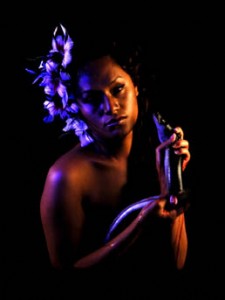« News US
Shigeyuki Kihara: Living Photographs

Shigeyuki Kihara. Sina ma tuna: Sina and Her Eel. Faleaitu: House of Spirits series. C-print on dibond aluminum, 2003. Overall: 33 1/2 x 29 9/16 x 15/16 in. (85.1 x 75.1 x 2.4 cm). Courtesy of artist Shigeyuki Kihara and photographer Sean Coyle
October 7, 2008-February 1, 2009
Lila Acheson Wallace Wing, 1st floor
Shigeyuki Kihara is a multimedia and performance artist who uses photography to explore themes of Pacific culture, identity, indigenous spirituality, colonialism, stereotypes, gender roles, and consumerism. Kihara was born in Samoa and is of Japanese and Samoan descent. She lives in Aotearoa/New Zealand.
Inspiration for Kihara’s work comes from a variety of sources, including nineteenth- and early twentieth-century colonial photographs made by non-indigenous artists who contributed to perceptions-many of them erroneous-about Pacific Islanders and their culture.
In the Black Sunday series, Kihara chooses to rework historical photographs and postcards into collages that are rephotographed. In Gossip Sessions and Show No Evil, Kihara clothes young women who were typically pictured naked. In Distressed Maiden she transforms the stereotypical theme of the “dusky maiden,” the subject of a multitude of colonial images. The woman seen in Tasi ae afe: One but a Million wears the headdress of a taupou-a daughter of a Samoan high chief and a ceremonial maiden who represents her community and extended family. Her portrait is slashed to allude to a series of iron bars, immobilizing the taupou in the picture and through the gaze of the photographer. Afa tasi: Half of One also comments on the collectivity of the community represented by an individual.
In the series Fa’a fafine: In a Manner of a Woman, Kihara makes powerful statements about the depiction of Samoan people, shared memory, societal roles, and sexuality. The Samoan word fa’a fafine is best described in Western terms as a third gender. The artist, herself a fa’a fafine, re-creates studio tableaux similar to the scenes staged by nineteenth-century non-Samoan photographers such as Thomas Andrew and Alfred John Tattersall, where women and men were posed alone and as couples partially clothed and often with tropical foliage. In the triptych Kihara is seen on a couch in a provocative, reclining pose that evokes numerous historical photographs of lounging seductive women, often captioned as Samoan “belles.” The series is a powerful commentary directed at Western perceptions of Pacific Islanders and the sexual stereotypes that were generated by early images. Presented as male and female, Kihara confronts and challenges assumptions about gender identity.
The series Faleaitu: House of Spirits celebrates aspects of the coconut tree through a humanized manifestation. The coconut tree is an essential plant in Samoa and integral to a variety of functional and ceremonial art forms.
In Vavau: Tales from Ancient Samoa, Kihara presents herself as characters in Samoan creation stories and folklore. With the artist seen as a man and a woman in Maui ti’eti’etalaga and Tonumaipe’a, she again explores life roles while embracing and visualizing traditional cultural beliefs.
Filed Under: News US


































